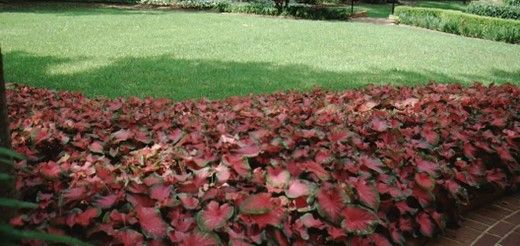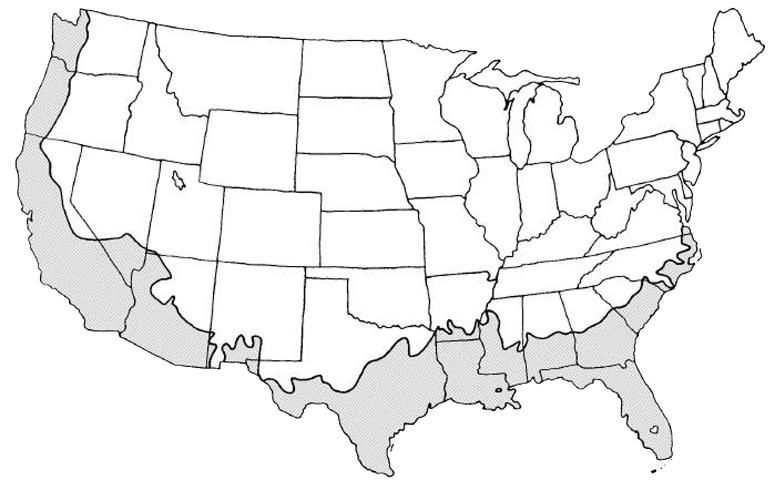Introduction
The distinctive arrow-shaped foliage of caladium is available in a large array of color combinations and heights, allowing a profusion of landscape applications. Most effective when massed together, caladium displays a neat growth habit and a multitude of beautiful leaves emanating from a single tuber. This plant draws attention when mass planted as a groundcover or edging. It also looks great planted in a container in a shady spot.

Credit: Edward F. Gilman, UF/IFAS
General Information
Scientific name: Caladium x hortulanum
Pronunciation: kuh-LAY-dee-um x hor-too-LAY-num
Common name(s): caladium
Family: Araceae
Plant type: perennial; ground cover; herbaceous
USDA hardiness zones: 8 through 11 (Figure 2)
Planting month for zone 8: year round
Planting month for zone 9: year round
Planting month for zone 10 and 11: year round
Origin: not native to North America
Invasive potential: not known to be invasive
Uses: container or above-ground planter; ground cover; edging; border; accent; suitable for growing indoors
Availability: generally available in many areas within its hardiness range

Description
Height: 1 to 2 feet
Spread: 1 to 2 feet
Plant habit: upright
Plant density: open
Growth rate: fast
Texture: coarse
Foliage
Leaf arrangement: most emerge from the soil, usually without a stem
Leaf type: simple
Leaf margin: undulate
Leaf shape: ovate; cordate; saggitate (arrow)
Leaf venation: palmate
Leaf type and persistence: deciduous
Leaf blade length: 8 to 12 inches
Leaf color: purple or red; green
Fall color: no fall color change
Fall characteristic: not showy
Flower
Flower color: white
Flower characteristic: summer flowering
Fruit
Fruit shape: unknown
Fruit length: unknown
Fruit cover: fleshy
Fruit color: unknown
Fruit characteristic: inconspicuous and not showy
Trunk and Branches
Trunk/bark/branches: not applicable
Current year stem/twig color: not applicable
Current year stem/twig thickness: not applicable
Culture
Light requirement: plant grows in the shade
Soil tolerances: clay; sand; acidic; loam
Drought tolerance:
Soil salt tolerances: poor
Plant spacing: 6 to 12 inches
Other
Roots: not applicable
Winter interest: no special winter interest
Outstanding plant: plant has outstanding ornamental features and could be planted more
Invasive potential: not known to be invasive
Pest resistance: long-term health usually not affected by pests
Use and Management
Growing best in partial shade, caladium is tolerant of full sun conditions when provided with rich soil and sufficient moisture. Tubers should be set 3 to 5inchesdeep in loose soil. Space plants on 8 to 12inchcenters for a thick ground cover effect. Mass plants in the front of a shrub border to accent an area. It grows nicely in the shade of existing trees.
Except in USDA hardiness zones 8b through 11, caladium tubers need to be dug and stored each year before frost. Even in locations where caladiums may be left in the ground, the tubers seem to perform better when dug and protected from wet winter soils. Water should be gradually withheld as the leaves naturally start to yellow in fall, then the tubers dug, cleaned of soil, and left to dry in semi-shade for about 10 days. The tubers should be dusted with an insecticide-fungicide prior to being stored in dry peat moss or vermiculite at temperatures between 50°F to 60°F. This helps prevent rot.
A few of the many popular caladium cultivars available include: 'Frieda Hemple', lush solid red leaves with a green border, 18 inches tall; 'Carolyn Wharton', large bright pink leaves with rose veins flecked with green, 24 inches tall; 'White Christmas', white leaves with green veins, 24 inches tall; and 'Little Miss Muffet', compact growth, lime green leaves dotted red, 8 inches tall. There are many others.
Propagation is usually by division of the tubers and rarely by seed.
Problems include mealy bugs, slugs, snails, caterpillars, mites, and grasshoppers. None are normally very serious.
Pests and Diseases
Tubers are susceptible to fungal diseases.